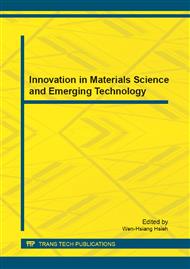p.134
p.138
p.143
p.149
p.154
p.159
p.164
p.169
p.174
Optimization of Enzymatic Hydrolytic Extraction Conditions for High Yield Polysaccharide Manufacturing from Liquid Fermented Materials of Hypsizigus Marmoreus
Abstract:
Polysaccharides extracted from fruiting body and mycelia of higher fungi have been found to show various biological activities. Traditionally, these polysaccharides are manufactured by the hot water extraction method. Low polysaccharide yield is the disadvantage of this method. This paper reports the optimal conditions to manufacture polysaccharide with high-yield from Hypsizigus marmoreus mycelia using enzymatic hydrolytic extraction method. Neutral protease was selected as the most cost efficient among six enzymes. The uniform design was further conducted to optimize the enzymatic hydrolytic extraction conditions, and a regression model was constructed to predict polysaccharide yield. The optimized procedures was that 2% (w/w) of neutral protease was added into hydrolytic solution and incubated for 4 h at 43°C, then extracted one time at 100°C for 1 h. Under optimized procedures, the measured polysaccharide yield was 15.73±0.15 (mg/g), which was very close to the predicted value of 16.65 (mg/g). The results validated the accuracy of the regression model and the optimized procedure. When following the optimized procedures, polysaccharide yield was raised 75.0% over that before optimization, and increased by 122.5% and 104.8% over hot-water extraction and microwave assisted extraction methods respectively. This was the first study to apply uniform design for optimizing high yield manufacture of mycelia polysaccharides by enzymatic hydrolytic extraction. We concluded that enzymatic hydrolytic extraction was a simple, high yield method to manufacture polysaccharides from mushroom mycelia and might be used widely in polysaccharide-derived functional foods production.
Info:
Periodical:
Pages:
154-158
Citation:
Online since:
December 2011
Authors:
Price:
Сopyright:
© 2012 Trans Tech Publications Ltd. All Rights Reserved
Share:
Citation:


